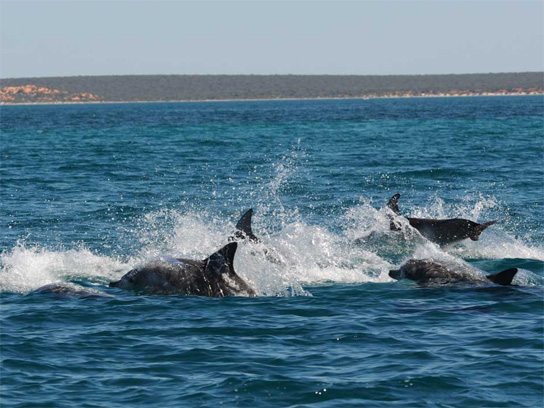
In Shark Bay, Australia, the male dolphins are well known to marine biologists for their messy social entanglements. These relationships are so unique, that they’re more like intricate webs of the way that the Cosa Nostra and the Mafia work than the typically vertical hierarchies of chimpanzees. A team of scientists argues in a recent article, published in the journal Proceedings of the Royal Society B, that this social system is unique among mammals.
These complex, and sometimes cooperative, relationships might stem from one simple and somewhat unexpected factor. These dolphins tend to swim at low speeds. Two or three adult males will form a tight alliance and cooperate to herd a female for mating purposes. Female dolphins don’t form strong alliances. The males in the first-level alliance form partnerships with other first-level alliances, creating a larger second-level alliance to protect the females, especially if they are in estrus.

The larger, second-level alliances, can have as many as 14 dolphins and can last more than 15 years. They can even marshal troops from other groups, leading to huge battles and skirmishes over the right to keep or steal a single female.
Researchers wanted to discover if these dolphin battles were similar to chimpanzee battles, where the males are fighting over territory. The team, led by Richard Connor, a cetacean biologist at the University of Massachusetts, Dartmouth, tracked 12 of the second-level alliances in Shark Bay, a 13,000-square-kilometer (5,000-square-mile) bay in western Australia.
The team tracked the dolphins over six years during the peak mating periods. It was discovered that, unlike chimps, dolphins weren’t interested in territory. They lived within a mosaic of overlapping ranges, that were patrolled by males and females. The dolphins live in an open society, with groups teaming up and splitting apart, while continually measuring who stays on top and deciding whether to stay friends or foes.
None of the other mammals with complex relationships are able to go outside their immediate community to form alliances. Only elephant society comes close, but they live in matrilineal groups and they aren’t as changeable as dolphin alliances.
Female dolphins give birth to single calves every few years, which means that the males cannot form alliances with close kin. This pushes male dolphins to learn how to make and maintain friendships, demanding social skills that might have contributed to the dolphins’ larger brains.
Connor thinks that their high level of social cognition, which is a convergence for not only dolphins, but humans and elephants as well, may be due to the minimal amount of energy these species expend when moving at slow speeds. The slow speeds force these dolphins to forge new alliances whenever they meet other groups.
Reference: “Physical competition increases testosterone among Amazonian forager-horticulturalists: a test of the ‘challenge hypothesis’” by Benjamin C. Trumble, Daniel Cummings, Christopher von Rueden, Kathleen A. O’Connor, Eric A. Smith, Michael Gurven and Hillard Kaplan, 28 March 2012, Proceedings of the Royal Society B.
DOI: 10.1098/rspb.2012.0455